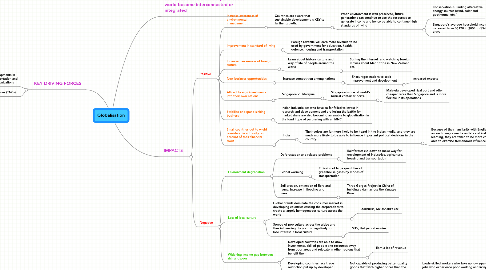
1. KEY DRIVING FORCES
1.1. Developments in transportation and communications
1.2. Transnational Corporations (TNCs)
2. Process by which people, their ideas and their activities in different parts of the world become interconnected or integrated
3. IMPACTS
3.1. Positive
3.1.1. Increase awareness of environmental management
3.1.1.1. Countries are aware that sustainable development is KEY to further growth.
3.1.1.1.1. When environment is well preserved, future generations can continue to use the resources to generate income and hence be able to continue high standards of living
3.1.2. Improvement in standard of living
3.1.2.1. Foreign revenue will earn more revenue to be used by government for education, health, defence, housing and transportation
3.1.3. Increased awareness of foreign culture
3.1.3.1. Learn about history, culture and way of life of people around the world
3.1.3.1.1. Surfing the Internet and watching foreign movies about Maori tribe in New Zealand etc.
3.1.4. New business opportunities
3.1.4.1. Increase competition among nations
3.1.4.1.1. Encourages nations to seek improvement and development
3.1.5. Attract foreign investments into their own nations
3.1.5.1. Singapore VS Malaysia
3.1.5.1.1. Singapore is one of world's busiest container ports.
3.1.6. Stabilize or expand sinking business
3.1.6.1. Indian industrialists who have so far failed to invest in research and development and are losing the battle for market share are also becoming amenable to globalization in the fond hope of partnering with an MNC
3.1.7. Small countries get to wield considerable authority on account of their financial clout
3.1.7.1. India
3.1.7.1.1. Their voices are far more likely to be heard in the Indian media, and they are much more likely to be able to influence important political decisions in the country.
3.2. Negative
3.2.1. Environment degradation
3.2.1.1. Deforestation and related problems
3.2.1.1.1. Rainforests cut down to make way for development of industries, agriculture, housing and transportation
3.2.1.2. Global warming
3.2.1.2.1. Emission of large quantities of greenhouse gases by modes of transportation
3.2.1.3. Soil erosion, extinction of flora and fauna, increase in flooding and haze
3.2.1.3.1. Three Gorges Project in China of building a dam across the Yangtze River
3.2.2. Loss of local culture
3.2.2.1. Global brands dominate the consumer market in developing countries causing the corporations to create a largely homogeneous culture across the world
3.2.2.1.1. Starbucks, McDonald's etc.
3.2.2.2. Spread of pop culture across the globe and thus influencing the youths negatively to lose interest in local culture.
3.2.2.2.1. MTV, Hollywood movies
3.2.3. Widening income gap between rich and poor
3.2.3.1. Developed countries are able to draw investments, skilled people and resources away from poor areas and relocate in other regions that benefit them
3.2.3.1.1. Earn a lot of revenue
3.2.3.2. Developing countries face trade restriction put up by developed countries
3.2.3.2.1. Not capable of producing better quality goods that fetch higher prices than the developed countries do.
3.2.4. Decreased accessibility to social services
3.2.4.1. Healthcare etc
3.2.5. Social segregation and political shifts
3.2.5.1. Riots etc.
